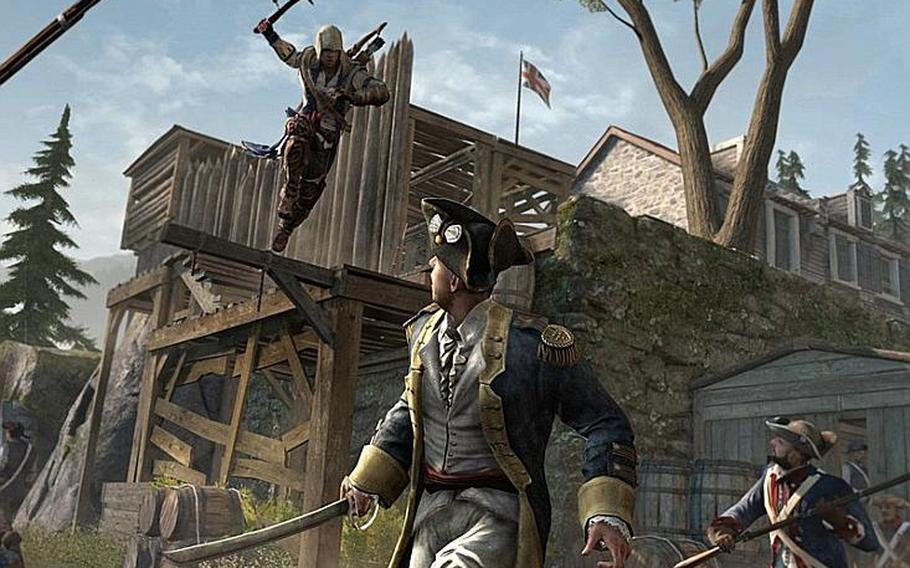
The age-old struggle between the Assassins and the Templars arrives in North America in 'Assassin's Creed III.' (Ubisoft)
Paul Revere didn’t exactly yell, “The Templars and coming! The Templars are coming!” But I almost expected him to.
Ubisoft revises Colonial and Revolutionary War history in its latest chapter in the centurieslong struggle between the Assassins and Templars. In the M-rated “Assassin’s Creed III,” players get an insider’s view of the French and Indian War, the Boston Tea Party and other events in early American history.
Altaïr’s Crusader era and Ezio’s Renaissance are long gone in what is actually the fifth installment of the series. In the new game, you play as two different men from the Boston area. You start off as an Englishman named Haytham. However, you spend the bulk of the game playing as his son Connor, the result of a liaison with a Native-American woman.
The men interact with many of the day’s heroes and participate in events that shaped the American struggle for independence. These encounters range from witnessing the signing of the Declaration of Independence to hearing Ben Franklin’s reasons for preferring flings with older women. You’ll ride with Paul Revere and visit the Continental Army during its winter encampment at Valley Forge.
The Revolutionary story line is among the best in the series so far. Missions are well integrated into the plot and there’s plenty of interesting interaction among the characters.
The settings look and “feel” right for the time period. The streets of Boston and New York are teeming with immigrants, dogs and pigs. The Georgian architecture is very convincing — though nowhere near as interesting as the cities of the Mideast or Renaissance Italy, which were featured in previous games. The wilderness is suitably primeval.
As in previous editions of “Assassin’s Creed,” the main story is actually sort of a dream created from the “genetic memories” of a modern descendant of the featured assassin. This man, Desmond, is attached to a machine that lets him relive the memories in order to gain information that can be used against modern members of the Templar order and also to save the world from looming disaster.
I’ve never been a big fan of the Desmond side of the coin, thinking it was weird and a waste of time. This edition doesn’t do anything to change my mind. Fortunately, his scenes tend to be brief so they don’t detract much from the game.
While the game does a good job of providing a taste of early American history, it probably won’t satisfy a true history buff. Most British soldiers look more like farmers in red coats and most American Minutemen looked like French musketeers. I was particularly irked by the appearance of an “American flag” over a captured fort in 1773, well before such a flag existed. However, these and other inaccuracies and anachronisms won’t ruin the game for anyone.
The basic game play is similar to previous “Assassin’s Creed” adventures. Your time is divided among climbing around the surrounding environment, killing enemies and building up a settlement. However, much has changed.
The biggest change in the parkour portions of the game is that you spend more time climbing trees and leaping from limb to limb than scaling tall buildings. The mechanics of treetop travel are smooth and effortless. And while the forests aren’t as interesting to explore as Renaissance Rome, they do offer the chance to hunt. The resulting pelts can earn you lots of cash to spend on weapons and gear.
Combat is still fluid and fun, with a wide range of attack styles that can prompt interesting cinematics depicting your exploits. It’s still very important to be stealthy and rely on your blade whenever possible. The biggest change in combat involves the appearance of muskets. While noisy, they let you kill enemies at longer range. They’re also equipped with bayonets, which can be handy for dispatching survivors of your initial attack.
The game also introduces naval combat to the “Assassin’s Creed” formula. As Connor, you fix up a ship, recruit a crew and embark on adventures escorting convoys, attacking seacoast fortifications and harassing enemy shipping. The missions are generally pretty easy thanks to the forgiving nature of the control scheme. Ships turn easily on their keels and stop on a dime. Reloading cannons, changing sail and aiming are all a breeze. Of course it’s nowhere near realistic, but it is a lot of fun.
The game again lets you establish a thriving community around your headquarters. You can invite different artisans and professionals to join your endeavor, which opens up new supplies of goods that can be used for trade or to upgrade your equipment. Your newfound friends also provide a lot of interesting side quests, ranging from dealing with an abusive husband to playing match-maker.
In addition to the single-player campaign, the game offers multiplayer competition. These matches revolve around an intricate game of cat-and-mouse in which you try to stab specific targets while avoiding specific pursuers. While players are rewarded for stealth and cunning, the games generally involve a lot of crazed scurrying over and around buildings with very little attention paid to finesse.
Overall, the graphics are pretty good, with most settings and characters looking pretty realistic. However, there are a large number of visual glitches. When Connor stands atop a church steeple, he actually hovers a few inches above it. When he kills an enemy atop a building, the body sometimes hovers in midair for a moment before falling to the ground. And, though assassins are masters of many things, I was surprised to see Connor walk through tables and other objects.
The game earns its mature rating for swearing and some blood, as well as the violence.
Bottom line: “Assassin’s Creed 3” delivers an exciting adventure, terrific game play and one of the most interesting stories in the franchise.
Platforms: Xbox 360 (tested on), PlayStation 3, PC
Online: www.assassinscreed.ubi.com